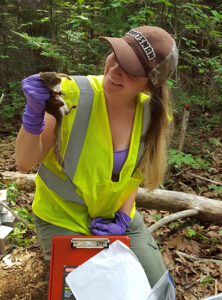Risky Business: Tick-borne Disease in Acadia National Park

By connecting natural and social science, a new research project aims to lower risks to public health
While an undergraduate at Indiana University of Pennsylvania, one of Sara McBride’s professors taught a class on Lyme disease and conducted tick research in Pittsburgh city parks. Intrigued, McBride volunteered to help with the work on weekends.
“In his class we read the book Lyme Disease: The Ecology of a Complex System by Richard Ostfeld, which I found fascinating,” McBride recalls. So fascinating, in fact, that upon graduation she took a job working with Ostfeld at the Cary Institute of Ecosystem Studies in Millbrook, NY, where she worked for two years.
When she arrived at UMaine to begin her Master’s Degree in the Ecology and Environmental Sciences program, McBride was well-prepared to participate in an interdisciplinary Mitchell Center project from the outset—a project designed to understand, and potentially reduce, risks of tick-borne diseases in Acadia National Park (ANP).
Armed with a bag of research tools to collect blacklegged (deer) ticks and to live-trap small mammals like tick-infested mice, McBride was immediately ready to get to work. “Through my prior work, I was able to gain experience in several field techniques that have been extremely valuable for my UMaine project, including tick sampling, small mammal trapping and vegetation surveying.”
McBride helped lead the field work in ANP when the project began in June 2018, and is continuing in that important role. Her work includes testing for tick-borne pathogens in ticks and in small mammals (via ear biopsies).
“Sara is central to the entire project, and has led all the ecological field work,” notes project co-leader Allison Gardner, assistant professor in Biology and Ecology, Mitchell Center Faculty Fellow, McBride’s faculty advisor, and a Second Century Stewardship fellow. Gardner studies the ecology of ticks and mosquitoes. “For her thesis project, Sara is developing a map of tick presence and risk of exposure to ticks in ANP.”
Says McBride, “Simply put, the modeling techniques we use will identify the environmental conditions at sites that we visit and have found ticks, and sites where we have not. It will then predict where ticks will be present and absent across the park—in areas where we have not physically visited—based on the environmental conditions in those areas.”
The research team plans to deliver the risk map to ANP scientists, which will be used to alert park staff and visitors of areas with a high risk of exposure to ticks. And, if all goes well, similar risk maps could be developed for other national parks where tick-borne diseases are prevalent.
“By helping us understand the ticks, the risks to public health, and the potential communication and management strategies to reduce risks, we’ll be able to make sound decisions based on strong science.”
Abe Miller-Rushing, Acadia National Park
There is a real sense of urgency surrounding the research team’s work. ANP had 3.53 million visits in 2018, the highest number in decades. Moreover, Maine has seen a five-fold increase in Lyme disease cases over the past decade. Both ANP visitors and nearby residents recognize the growing risks posed by tick-borne disease.
Tick Talk
In tandem with the ecological field research being conducted by Gardner, McBride, and other students, social scientist Sandra De Urioste-Stone, associate professor in Forest Resources and Mitchell Center Faculty Fellow, is leading a team of students conducting research with park visitors to understand their knowledge and concerns regarding ticks and tick-borne disease.
The social science team is also using surveys to study where in the park visitors have been and the types of recreation activities in which they’ve participated. Visitors are asked what kinds of protective behaviors they practice with tick-borne disease in mind, including using repellents or wearing long pants tucked into socks.
“Our students were surveying at Acadia every week all last summer until the end of October,” says De Urioste-Stone. “They talked with over 1,000 visitors. In our follow-up survey, we had over 400 responses. Visitors were very open to sharing their experiences.”
Based on this information, the team is generating maps that indicate the most visited destinations in ANP, including the most frequently used trails. These data will be incorporated into the final risk map that McBride is developing.

In recognition of the importance of the project, the team has been awarded a UMaine Interdisciplinary Undergraduate Research Collaborative grant. This has allowed them to recruit new undergraduate students for their second season of research. Students will assist with additional field work at ANP and help gather information about the perspectives of Mainers on ticks and tick-borne diseases in locales outside of ANP through a household survey.
Throughout the project, the team has worked to ensure that their research meets the needs of ANP staff. “We’re very fortunate to benefit from the team’s innovative approach,” says Abe Miller-Rushing, Science Coordinator at ANP. “By helping us understand the ticks, the risks to public health, and the potential communication and management strategies to reduce risks, we’ll be able to make sound decisions based on strong science.”
Management strategies under consideration could include moving trails out of areas where tick abundance is highest, and developing communication methods such as precautionary signs and handouts to help educate and protect park visitors. “The results of the social science research will play a key role in identifying which education strategies and behavior changes hold the most promise for lowering health risks,” says Miller-Rushing.
Other UMaine team members include Danielle Levesque, assistant professor of mammalogy and mammalian health in the School of Biology and Ecology, and Sean Birkel, research assistant professor in the Climate Change Institute who works on climate modeling.
